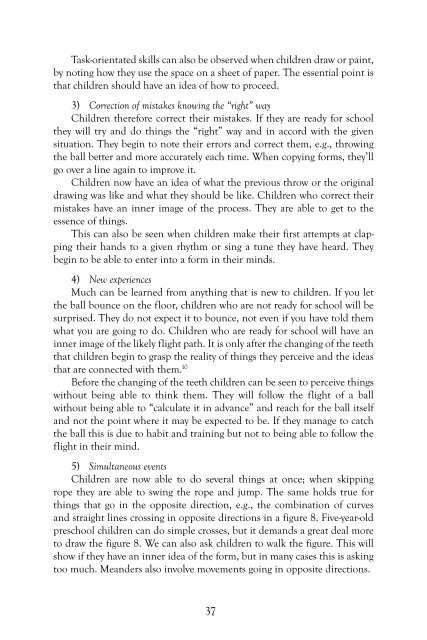When Healing Becomes Educating, Vol. 6 - Waldorf Research Institute
When Healing Becomes Educating, Vol. 6 - Waldorf Research Institute
When Healing Becomes Educating, Vol. 6 - Waldorf Research Institute
You also want an ePaper? Increase the reach of your titles
YUMPU automatically turns print PDFs into web optimized ePapers that Google loves.
Task-orientated skills can also be observed when children draw or paint,<br />
by noting how they use the space on a sheet of paper. The essential point is<br />
that children should have an idea of how to proceed.<br />
3) Correction of mistakes knowing the “right” way<br />
Children therefore correct their mistakes. If they are ready for school<br />
they will try and do things the “right” way and in accord with the given<br />
situation. They begin to note their errors and correct them, e.g., throwing<br />
the ball better and more accurately each time. <strong>When</strong> copying forms, they’ll<br />
go over a line again to improve it.<br />
Children now have an idea of what the previous throw or the original<br />
drawing was like and what they should be like. Children who correct their<br />
mistakes have an inner image of the process. They are able to get to the<br />
essence of things.<br />
This can also be seen when children make their first attempts at clapping<br />
their hands to a given rhythm or sing a tune they have heard. They<br />
begin to be able to enter into a form in their minds.<br />
4) New experiences<br />
Much can be learned from anything that is new to children. If you let<br />
the ball bounce on the floor, children who are not ready for school will be<br />
surprised. They do not expect it to bounce, not even if you have told them<br />
what you are going to do. Children who are ready for school will have an<br />
inner image of the likely flight path. It is only after the changing of the teeth<br />
that children begin to grasp the reality of things they perceive and the ideas<br />
that are connected with them. 10<br />
Before the changing of the teeth children can be seen to perceive things<br />
without being able to think them. They will follow the flight of a ball<br />
without being able to “calculate it in advance” and reach for the ball itself<br />
and not the point where it may be expected to be. If they manage to catch<br />
the ball this is due to habit and training but not to being able to follow the<br />
flight in their mind.<br />
5) Simultaneous events<br />
Children are now able to do several things at once; when skipping<br />
rope they are able to swing the rope and jump. The same holds true for<br />
things that go in the opposite direction, e.g., the combination of curves<br />
and straight lines crossing in opposite directions in a figure 8. Five-year-old<br />
preschool children can do simple crosses, but it demands a great deal more<br />
to draw the figure 8. We can also ask children to walk the figure. This will<br />
show if they have an inner idea of the form, but in many cases this is asking<br />
too much. Meanders also involve movements going in opposite directions.<br />
37

















